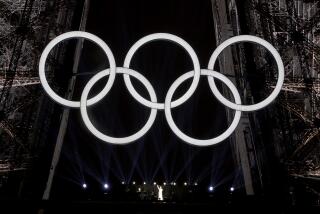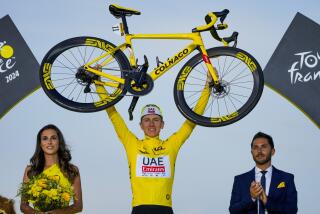Lance Armstrong recycles stardom
- Share via
It took only one move for Lance Armstrong to draw all eyes upon him and the Tour de France.
It came midafternoon on Monday, Day 3 of cycling’s most prestigious race, when a sudden and vicious crosswind whipped across the sun-baked area known as the Camargue in southeastern France. The 37-year-old Texan, chasing an impossible dream in what has been a most improbable comeback, stood up in his saddle and pounced.
The rival Columbia-HTC team made a bold push to take the lead of the peloton and Armstrong, four years after retiring and 10 months after announcing -- amid scoffs -- that he would take up competitive cycling once more, saw it coming and broke into a sprint.
That is all it took.
The Tour, once heaped with scorn amid numerous doping cases, is must-see TV again. Riding for Team Astana, the man who prevailed over cancer and has won an unprecedented seven Tours is back.
“What you saw from Lance this week was both strong riding and smart riding,” said Columbia team veteran George Hincapie, who was Armstrong’s teammate for all seven victories and spoke by phone from Barcelona, where Thursday’s stage ended. “The guy is in great shape, plus he’s so smart.”
On Monday, Armstrong jumped from 10th to third, 40 seconds behind the leader, Fabian Cancellara. And in Armstrong’s wake, his chief rivals -- including once-presumed Astana leader Alberto Contador, who became testy afterward -- were left bobbing helplessly behind, colorfully clad buoys scattered about the open road.
As Day 7 gets underway today, Armstrong is 0.22 of a second away from the lead and heading into the climbing stages of the Pyrenees, long his greatest strength.
His surprising performance has dramatically increased crowds and excitement in France, where Armstrong over the years has had a disagreeable relationship with both the owners of the race and the French public over unproven doping allegations.
Yet, like every cyclist in this race, Armstrong has been repeatedly tested for illegal substances by his team, the International Cycling Federation and the Tour itself. He has said via Twitter that he has been tested more than 30 times since January.
And he still hasn’t failed a drug test.
There is no getting away from the scrutiny of the Tour, which tests every stage winner and daily jersey holders and conducts unannounced tests throughout the 21-day race. Last year, some riders were caught using a drug called CERA, a newer version of the growth hormone EPO that had snared dozens of riders over the last decade.
Armstrong is inured to controversy, though, whether it concerns drug testing or the race itself.
For example, his push on Monday escalated tensions with Contador over who would emerge as Astana’s team leader. Contador, 26, is eager to build on his 2007 Tour victory and, until Armstrong’s return, was the unrivaled top rider.
After Monday’s stage, Contador dismissed Armstrong’s savvy move by saying, “I’ll let what he did speak for itself.”
An unflappable Armstrong replied, “I have won seven of these races. I think I know what I’m doing.”
What he did was capture the imagination of fans everywhere and shake the race alive.
Instead of headlines trumpeting another cycling star being kicked out for doping -- Armstrong’s archrival Jan Ullrich in 2006 among them -- attention is on Armstrong’s relentless move up the standings.
“With what Lance did,” said Columbia owner and Riverside native Bob Stapleton, by phone from France, “this Tour has become the biggest thing going in Europe and the U.S. too, I think. The intensity level over here is amazing. All anyone is talking about is Lance.”
Paul Sherwen, a former elite cyclist and now an analyst on the live coverage on Versus, has no doubt what will happen next.
“I expect to see Lance in the yellow jersey after Friday’s stage,” he said. “What he has done this week already is amazing.”
When Armstrong announced in September that he was coming back, he said his motivation was simple. He wanted to raise awareness and money, through his Lance Armstrong Foundation, to help find a cure for cancer.
--
Champion’s cause
And there is no denying his commitment to that cause. Armstrong survived the disease himself in 1997, recovering from testicular cancer that had spread to his brain. Last January, when Armstrong rode in his first comeback race at the Tour Down Under in Australia, he spent an afternoon with cancer patients, at one point tearing up as he listened to the story of a young mother who was fighting breast cancer. It is by design that at every stop in his comeback, Armstrong has made a point to visit a hospital oncology ward.
“If I don’t win another race,” Armstrong said in Australia, “it doesn’t matter. This is my fight. Cancer is my motivation.”
But if he could win another major cycling title, that would be nice too.
That all seemed unlikely before this week, especially after Armstrong crashed in March and broke his collarbone, the first serious injury in a 20-year career. And it was widely known that in retirement, he partied, dated celebrities and enjoyed life outside the strict confines of cycling training in which it is necessary to measure food portions and heart and lung capacity daily.
“This is a 37-year-old cyclist competing in, by far, the toughest race ever, and he’s come out in the first week and done things that are absolutely ridiculous, stunning,” said Sean Petty of USA Cycling. “I think it shows that you can never, ever take Lance for granted.
“If he were to win this I think it would, in its way, be more spectacular than what he accomplished winning seven.”
Today’s nearly 140-mile stage will be the first serious test of Armstrong’s climbing fitness. The stage leaves Barcelona, meanders into the Pyrenees and finishes at about 7,300 feet. It is made, according to the Tour de France guide, for “the bold, sturdy climber who breaks away from the pack early to seize his chance.”
Sunday’s stage is even tougher, 99 miles of up and down, across two historic Pyrenees passes at Aspin and Tourmalet.
“He came into the Tour lighter than he’s ever been,” said Chris Carmichael, Armstrong’s longtime trainer. “All his numbers that indicate endurance and strength are better than ever. What we need to see now is whether his climbing legs are there.”
The race, however, may not be decided until the final climb on July 25 up Mt. Ventoux, a wind-swept, broiling hot, rocky summit where British cyclist Tim Simpson died climbing in 1967.
“I think this race will go down to Ventoux,” Hincapie said. “And Lance will be there.”
--
More to Read
Go beyond the scoreboard
Get the latest on L.A.'s teams in the daily Sports Report newsletter.
You may occasionally receive promotional content from the Los Angeles Times.










